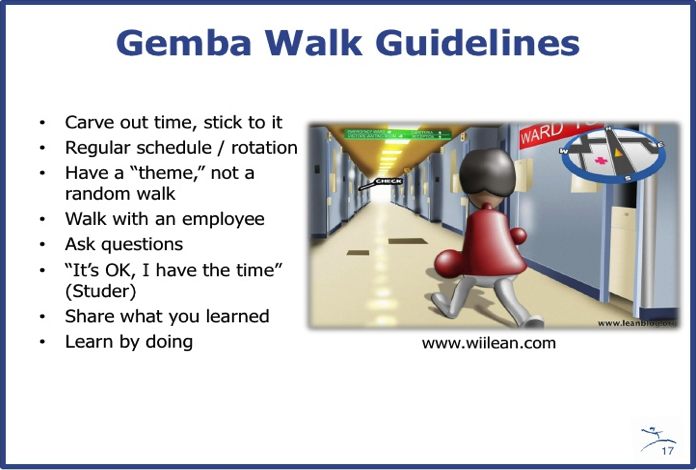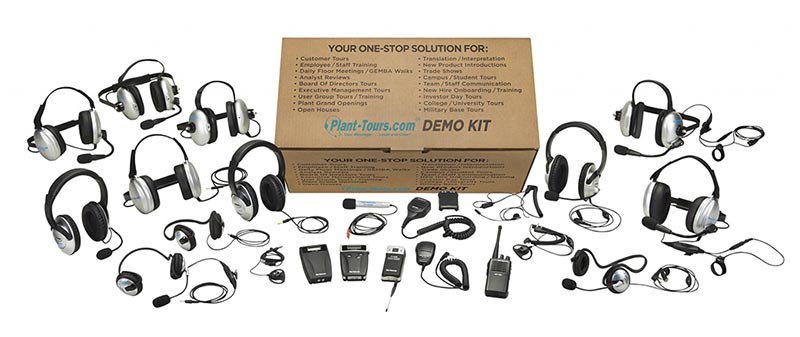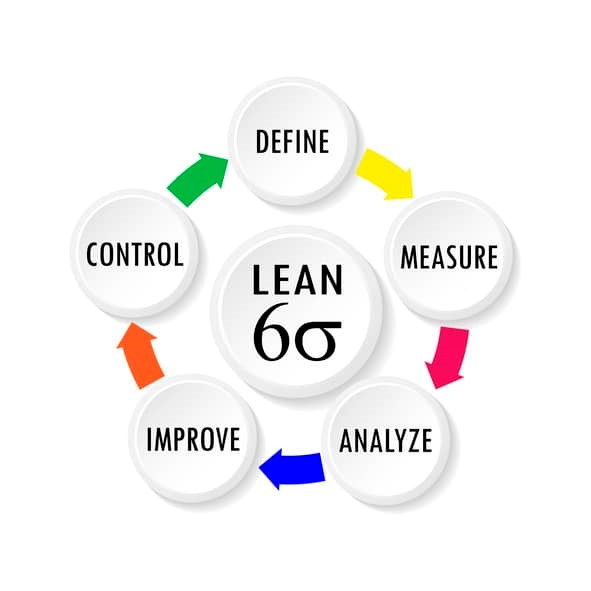Gemba walks taken by management to promote the continuous improvement of manufacturing in their facilities are becoming increasingly popular in the West. Popularized by Taiichi Ohno in the 1990s, when he brought a struggling Toyota plant to an unprecedented level of success, these walks and the overall methodology and philosophy that goes along with them have really taken off. Many people in a wide array of businesses are wondering if these walks can help improve their manufacturing business processes and thus their bottom line.
A gemba walk is about a lot more than merely taking a leisurely stroll around the facilities, however. While simplistic, they are quite involved in setting up properly. Gemba is a Japanese word meaning the “real place,” and thus taking these walks requires you to be in the actual place of business. The kicker here is that this is both literal and metaphorical. You have to see and observe, but you also have to become part of the standard work on the shop floor so that you can best determine the right problem-solving measures and improvement efforts required to achieve a greater level of success. It is a fantastic management tool.
The real-time observation of the work process can help you stop wasteful activities and eliminate redundancies while also improving overall morale and helping you construct an effective front line for your manufacturing. If it worked for the Toyota production system, in that insanely competitive industry of Japanese automobiles, then it can certainly work for your business if done correctly.
Just to be clear, this isn’t the same as the more line-driven management by walking around (MBWA) for process improvement, whereby managers/owners act more like hall monitors and essentially motivate employees to work harder through their looming presence. Not that such a system doesn’t have its benefits, of course; it’s just different from gemba walks. This is lean management. This is all about kaizen: a “continuous improvement” or “change for the better” as it translates. This is about observing the root cause of issues and also implementing action plans, including lean teams using Kanban software to recognize KPI, etc.
Not to get too bogged down in those details, but Plant Tours can help you learn all about these things individually. For now, we want to focus on an effective gemba walk. Here are 10 steps to having successful walks so that you can shore up everything from your kaizen principles to your value stream with customers. Don’t forget to always check out our gemba walk checklist.
10 Effective Ways to Do a Gemba Walk
If you have a mind to go searching around for gemba walks and tips to help you pull one off, don’t be surprised to find yourself inundated with multiple results; everything from webinars and podcasts to a variety of colorful infographics work to illustrate how to do a gemba walk. However, the key here is an effective gemba walk. It’s free to post content online, and so you may run into a lot of stuff that’s giving you pretty shoddy advice or general stuff that fits for any sort of workplace philosophy. At Plant Tours, we want to give you detailed information on how to observe the “actual place”: your shop floor and how to create plans from your real-time observations. This is all about you being on the front line and doing a gemba walk the right way.
1. Create a Team
The philosophy of kaizen requires a team effort. Unlike MBWAs that usually happen, you’re not one lone authority figure strolling around the plant. You want to assemble a team. The idea here is that you need other individuals (at least one more, minimum) whose eyes you can rely on. Maybe you don’t see that the second shift is taking 10 seconds longer to get one item off the line compared to the first shift, but someone on your team may certainly notice that. When it comes to process improvement, you have to truly see all of the processes involved. This means that creating a leadership team to walk with you is going to be your best management philosophy tool.
2. Prepare a Plan
Toyota didn’t just start having surprise inspections by the bosses on the plant floor. That’s not how they turned things around. It was a sound philosophical approach that worked to find the root cause of each individual issue before ultimately ditching the wasteful activities and improving the work process. This took planning from step one, including how the walks would be performed. You should work on planning your areas of focus, the order of the walk, the time of the walk so you can schedule employee talks, etc. You need a good plan before you hit the floor, or else your walk won’t be successful and you’ll end up just having to rework it.
3. Follow the Process
The term “value stream” is used in business in a few different ways. It deals with your customers. It deals with the value your employees offer. It also deals with the flow of value from your manufacturing facility as it relates to gemba, the “real place.” There are parts of the shop floor whose value is higher than others. For Toyota, engines being built were of more value than doors and quarter panels. While everything goes into creating a product to be sold, those individual components are created separately and hold different values. You should be placing emphasis on high-value items and following the flow, looking to see what can be improved first in these areas of high value.
4. Ask Questions
There are things that you may not necessarily be able to observe with the eye or on your walks in general. There are some things that must be uncovered through dialogue, specifically things like employee morale and enthusiasm. The leadership team marching around on a planned gemba walk can always give a false positive reading if employees feel the need to act more chipper than they actually are. This is why it’s important to ask questions. Speak with your employees. Always ask why. Ask them if they’re happy. Also, beyond that, ask about the processes involved in workflow. You may not realize this, but employees understand how to streamline production better than anyone. If you don’t realize that they spend a lot of time thinking about more efficient ways to get their job done, then you definitely need to be asking them more questions.
5. Document All Observations
Taiichi Ohno was a scientist before he was fixing Toyota’s problems, and so in creating this system, he certainly instituted a sound methodology to follow and build off of. The idea here should be to document what you observe as well as documenting the answers to the questions you ask. Your other team members should be doing this. You’re not out there walking around just to observe and then go make determinations from memory and initial observation. It’s data you’re collecting out there. Remember this point: It’s basically the most important point of the entire gemba walk. You are out there to collect the data, and this data comes from a wide array of sources. It must be documented meticulously.
6. Analyze the Data
Of course, if the previous step was to collect the data, the next step would logically be to analyze it. You can plug this data into Kanban, you can see how it works relative to your KPI metrics, and you can do a lot more to ensure that you’re following a lean manufacturing protocol so that you’re making the necessary improvements. The thing here on which to focus is that you really want to be sure to analyze this data very carefully. If the goal is process improvement, then every single data point needs to be accurately observed, accurately recorded, and accurately analyzed. Remember, this is a scientific approach to a workplace philosophy. This is not only key to project management but also creating better processes. Show respect to this process.
7. Schedule at Different Times
Your plant probably doesn’t only run in one shift. You likely have different employees cycling in and out, and these different sets of employees will likely give you different results. They’re not robots; they’re humans, and there are countless things that can affect performance. The idea here is that you want to schedule your walks at different times so that you can observe different parts of the facilities with different personnel and thus gauge the overall performance better than just one shift. So, change things up in terms of your scheduling.
8. Never Suggest Any Changes During the Walk
Once you make a plan to go on a walk, you have to stick to that plan. There are a lot of times when something might arise during a walk that catches your attention. You want to then go look at a different section, suggesting you’ll circle back to the original plan. No; this is going to throw you off and skew your observations. You made a plan before the walk, so make sure that you actually stick to it. There’s no rule that says you can’t plan another walk immediately after, so just stick to your current plan and rework your route for the next walk.
9. Walk With Teams
We spoke above about creating your team. Well, we didn’t mean that this is something that should be done initially and then you can start walking solo. Walking with a team on regular gemba walks is something that should be done for every walk. No one said your leadership team had to be small. You can call in some employees, shift managers, floor managers, etc., and you can implement asking questions by getting them to speak to the employees they oversee as they assist you on your walk. Americans say, “Teamwork makes the dream work.” As corny as that may sound, there’s definitely an advantage to a team.
10. Return and Follow Up With Employees
Part of any effective gemba walk checklist should always include a follow up with your employees. Sure, you’re getting your firsthand take straight from their mouths while on your walk, but things change, and often quickly, so go see how your employees are doing. A satisfied employee on Monday could be dissatisfied on Wednesday due to a change you implemented. Let your employees know that they can be open and honest, and run a follow up so you can gauge how they’re dealing with it.
Gemba is a Japanese word and a Japanese concept, and it implements so many different bits of sound business models to create a functional philosophy, such as lean manufacturing and much more. Ohno actually expanded on the idea from Dr. W. Edwards Deming, who created a workplace philosophy using systems theory called Six Sigma. A lot of these principles are implemented in Ohno’s work.
We hope these tips for an effective gemba walk lead to success for your business. It’s a great template to follow, and it can be easily folded into your existing business process.
If you run Gemba Walks and need headsets for you teams make sure to check out our communication headsets for Gemba tours.









